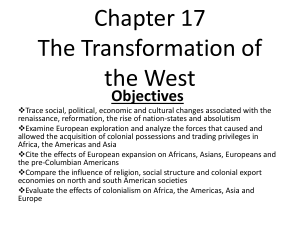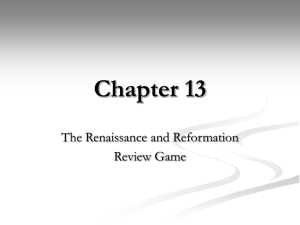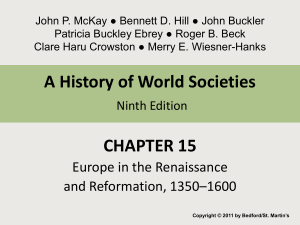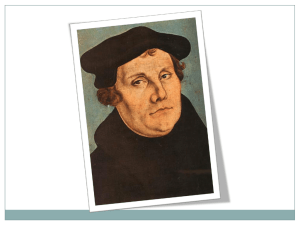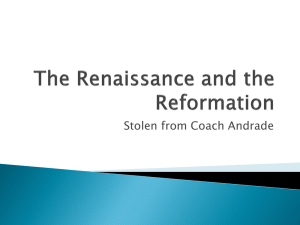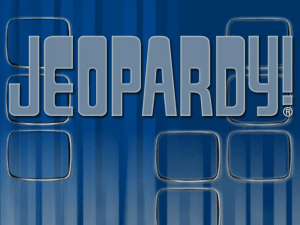UNIT 5 SPECIFICITIES Identify, Describe -
advertisement
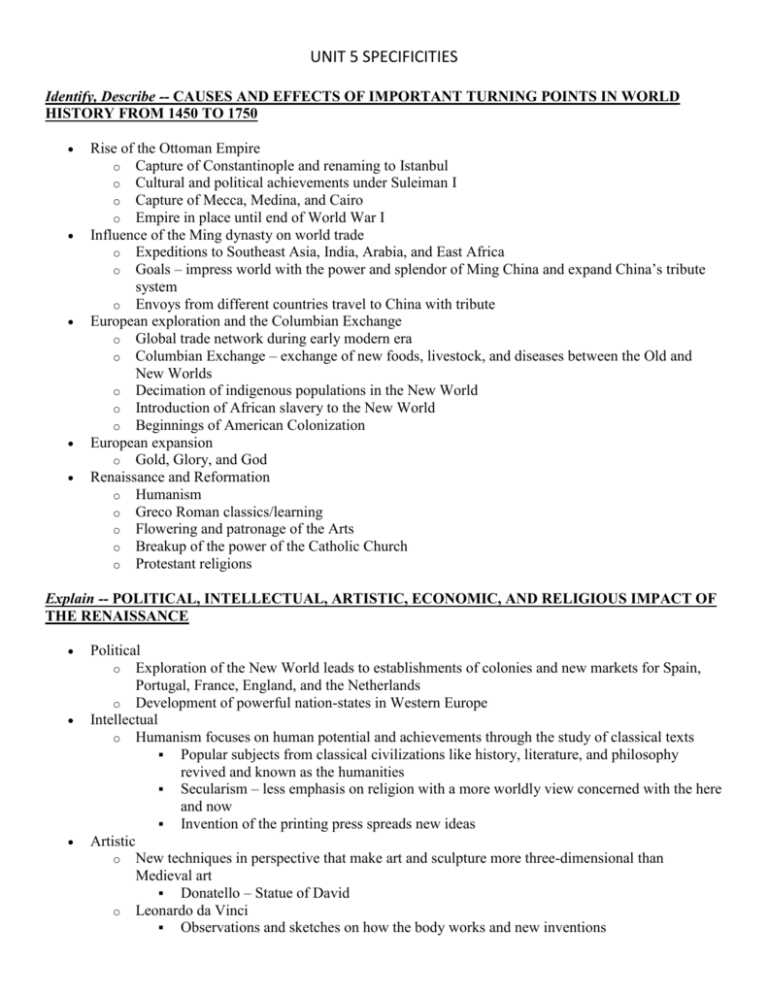
UNIT 5 SPECIFICITIES Identify, Describe -- CAUSES AND EFFECTS OF IMPORTANT TURNING POINTS IN WORLD HISTORY FROM 1450 TO 1750 Rise of the Ottoman Empire o Capture of Constantinople and renaming to Istanbul o Cultural and political achievements under Suleiman I o Capture of Mecca, Medina, and Cairo o Empire in place until end of World War I Influence of the Ming dynasty on world trade o Expeditions to Southeast Asia, India, Arabia, and East Africa o Goals – impress world with the power and splendor of Ming China and expand China’s tribute system o Envoys from different countries travel to China with tribute European exploration and the Columbian Exchange o Global trade network during early modern era o Columbian Exchange – exchange of new foods, livestock, and diseases between the Old and New Worlds o Decimation of indigenous populations in the New World o Introduction of African slavery to the New World o Beginnings of American Colonization European expansion o Gold, Glory, and God Renaissance and Reformation o Humanism o Greco Roman classics/learning o Flowering and patronage of the Arts o Breakup of the power of the Catholic Church o Protestant religions Explain -- POLITICAL, INTELLECTUAL, ARTISTIC, ECONOMIC, AND RELIGIOUS IMPACT OF THE RENAISSANCE Political o Exploration of the New World leads to establishments of colonies and new markets for Spain, Portugal, France, England, and the Netherlands o Development of powerful nation-states in Western Europe Intellectual o Humanism focuses on human potential and achievements through the study of classical texts Popular subjects from classical civilizations like history, literature, and philosophy revived and known as the humanities Secularism – less emphasis on religion with a more worldly view concerned with the here and now Invention of the printing press spreads new ideas Artistic o New techniques in perspective that make art and sculpture more three-dimensional than Medieval art Donatello – Statue of David o Leonardo da Vinci Observations and sketches on how the body works and new inventions Mona Lisa and The Last Supper o Michelangelo Architecture – St. Peter’s Basilica Art – Sistine Chapel Ceiling Sculpture – David o Raphael Realism in series of Madonna paintings School of Athens – connections to classical civilization Literature written in vernacular languages instead of Latin Economic o Merchant class develops power through trade and banking o Italian city-states dominated by merchants, who often support politicians with loans of money Medici family controls Florence o Nations that establish colonies through exploration grow wealthy with raw materials; beginning of mercantilism Religious o Christian humanists like Erasmus and Sir Thomas More address improvements in society through Christian motives, but with less emphasis on religious ceremony o Corruption in the Catholic church through simony, the sales of indulgences, and the worldly lifestyles of the clergy Explain -- POLITICAL, INTELLECTUAL, ARTISTIC, ECONOMIC, AND RELIGIOUS IMPACT OF THE REFORMATION Political o Europe becomes politically fragmented along religious lines and nations align themselves as either Catholic or Protestant Spain and France – Catholic England – Protestant Holy Roman Empire – Catholic with some of the northern principalities being Protestant under the Peace of Augsburg o Holy Roman Empire began to weaken as it struggled to maintain its power o Henry VIII establishes a protestant nation in England with the king as head of the Anglican Church. Act of Supremacy of 1534 gives Henry VIII legal sovereignty of civil laws over the laws of the Church of England. o Puritan revolt against the Anglican Church leads to civil war in England. o The state began to supersede the powers of the clergy. Intellectual o Lutheranism expanded educational opportunities for both men and women. o Invention of the printing press spreads religious ideas to different parts of Europe o Rising sense of individualism as people sought to create a better life for themselves Artistic o Protestant ideas shown in the artwork of the Northern Europeans o Protestant emphasis on the individual’s personal relationship with God was reflected in the number of common people and day-to-day scenes that were depicted in art. o Iconic images of Christ and scenes from the Passion became less frequent, as did portrayals of the saints and clergy. Narrative scenes from the Bible, and, later, moralistic depictions of modern life were preferred. Economic o Growth of economic powers for the middle class o New economic model of capitalism began to take shape Religious o o o o o o Unity in Europe as a Christian society was shattered by the different conflicts that erupted between Protestants and Catholics Catholic Counter – Reformation is a response to the Protestant Reformation Vernacular translations of scriptures allowed ordinary people to read the Bible and explore the truths of God for themselves. Protestantism gave people a new sense of coming to God without the intervention of the Church and priests. Persecution of perceived heretics in both the Catholic and Protestant churches Use of the Inquisition courts in Catholic Spain Books perceived to be heretical were banned. Compare -- MAJOR POLITICAL, ECONOMIC, SOCIAL, AND CULTURAL DEVELOPMENTS OF MAYA, INCA, AND AZTEC CIVILIZATIONS Explain -- HOW PRIOR CIVILIZATIONS INFLUENCED DEVELOPMENT OF MAYA, INCA, AND AZTEC CIVILIZATIONS Descendants of hunter-gathers who cross Bering Strait and migrate to Mesoamerica Olmec civilization (1200 BC-400 BC) influenced Maya civilization o “Mesoamerica’s Mother Culture” o Mexico’s Gulf coast o Large stone monuments and earthen pyramids o Elite ruling class of priests and nobles o Large trade network throughout Mesoamerica Zapotec civilization (1000 BC-600 AD) influenced Aztec civilization o Southwest Mexico – Oaxaca o Stone temples and pyramids o Calendar based on movement of the Sun o Hieroglyphic writing Andean cultures that influenced Inca civilization o Chavín (900 BC-200 BC) – religious civilization featuring temples; religious images and styles of art spread throughout Peru o Nazca (200 BC-600 AD) – irrigation systems that included underground canals; textiles and pottery; Nazca Lines (large drawings on soil of their gods) Explain -- HOW INCA AND AZTEC EMPIRES WERE IMPACTED BY EUROPEAN EXPLORATION AND COLONIZATION Aztecs conquered by Hernando Cortes (1519) Incas conquered by Francisco Pizarro (1532) o Superior weapons – muskets, cannons, armor o Use of the horse as a method of transportation o Diseases decimate native populations – smallpox, measles, mumps, typhus – no natural immunity o Intermarriage with native peoples produce a mixed-blood social class knows as mestizos o Enslavement and harsh treatment o Forced labor on farms, ranches, and mines through the encomienda system o Conversion to Christianity o Native resistance that resulted in armed conflict Analyze -- CAUSES OF EUROPEAN EXPANSION FROM 1450 TO 1750 Renaissance ideas Desire for trade routes, spices, and profits Desire to spread Christianity New technologies in ships and sailing Increase country’s power Absolute monarchs use their wealth and power to support the Age of Exploration Explain -- IMPACT OF COLUMBIAN EXCHANGE ON THE AMERICAS AND EUROPE Columbian Exchange – the global transfer of foods, plants, and animals during the European colonization of the Americas. These become staples in people’s diets in both regions. o Impact on the Americas New livestock including horses, cattle, sheep, and pigs. Horses led to the defeat of many Native Americans. Foods from Africa including bananas, black-eyed peas, and yams Grains such as rice, barley, wheat, and oats Diseases such as smallpox, measles, and influenza that led to the deaths of millions of Native Americans Slaves from Africa o Impact on Europe New foods and plants including corn, tomatoes, chocolate, tobacco, quinine, and potatoes Explain -- IMPACT OF ATLANTIC SLAVE TRADE ON WEST AFRICA AND THE AMERICAS Africa (particularly West Africa) o Political – trade in slaves promoted warfare between African states; European weapons (guns) become an important component of political power; Europeans control very little territory in Africa o Economic – Atlantic slave trade increased demand for African slaves by Europeans; volume of trade increased; trade patterns shifted to west coast; demand for European manufactured goods (guns) o Cultural – introduction of Christianity to west Africa; African artists created products for European markets o Technological – gunpowder guns The Americas o Increase in the African populations, both directly from Africa and those who were subsequently born in the Americas and Caribbean o The dispersal of Africans throughout the New World is directly related to slavery, as they were forced to go wherever labor was demanded. o British colonies, in what is now the southern United States, depend on slave labor for production of cash crops o Knowledge of agriculture, including rice that spread into the Southern colonies o Aspects of African food, music, and art leave a lasting influence on American cultures Explain -- IMPACT OF OTTOMAN EMPIRE ON EASTERN EUROPE AND GLOBAL TRADE Eastern Europe o Constantinople conquered in 1453 and renamed Istanbul Suleiman’s advances into Hungary and Austria in 1525, but expansion stopped with the Siege of Vienna in 1529 Global trade o Caravanseri (roadside inns) network – assured safety for traveling merchants and envoys o Naval trade in spices, wheat, and lumber throughout the Mediterranean, Aegean, Black and Red Seas, and the Persian Gulf o Explain -- MING CHINA’S IMPACT ON GLOBAL TRADE Ming Dynasty (1368-1644) Expeditions launched Impact of voyages: o Expeditions to Southeast Asia, India, Arabia, and East Africa o Goals – Impress world with the power and splendor of Ming China and expand China’s tribute system o Envoys from different countries travel to China with tribute Voyages end after Chinese scholar – Officials complain of financial waste China withdraws into isolation Explain -- NEW ECONOMIC FACTORS AND PRINCIPLES CONTRIBUTING TO THE SUCCESS OF THE COMMERCIAL REVOLUTION IN EUROPE Commercial Revolution – new business and trade practices brought about in Europe during the 16th and 17th centuries o New wealth brought from colonies in the Americas o Maritime innovations such as galleons and sextants increase overseas trade and voyages of exploration o Rise of capitalism – private ownership and investment of wealth for profit lead to the growth of the merchant class and an increase of the money supply. o Joint-stock companies (Jamestown, Virginia) – investors pooled their money together to establish American colonies and usually faced minimal monetary losses because of the large number involved in the investment. o Mercantilism – colonies provided gold and silver (bullionism), as well as a favorable balance of trade, since they were both suppliers of raw materials and markets to their mother countries o Establishment of new institutions such as banks, stock exchanges, insurance companies, and futures markets Locate -- PLACES, REGIONS OF HISTORICAL SIGNIFICANCE RELATED TO MAJOR ERAS AND TURNING POINTS Renaissance and Reformation: Italy, Rome, Florence Age of Exploration – Spain, Portugal, Cape of Good Hope, Spice Islands, The Middle Passage Absolute Monarchies in Europe: Prussia, Nantes, Paris, Versailles, St. Petersburg Imperialism – Africa, Belgian Congo, Nigeria, South Africa, French West Africa, Dutch East Indies, French Indochina, India Analyze -- EFFECTS OF PHYSICAL AND HUMAN GEOGRAPHIC FACTORS Trade in the Indian Ocean: European voyages of exploration bring spices from the East Indies and contribute to the Commercial Revolution in Europe Identify -- RELIGIOUS INFLUENCE Including, but not limited to: Examples of religious influence during the Renaissance including: o The relationship between politics and religion became strained o The political influence of the Catholic Church weakened Describe -- INFLUENCES OF WOMEN IN WORLD HISTORY Elizabeth I (1533-1603) – Queen of England who restored Protestantism and defeated the Spanish Armada, which solidified England as a major naval power Explain -- RELATIONSHIP BETWEEN CHRISTIANITY, INDIVIDUALISM, AND GROWING SECULARISM AND HOW THIS INFLUENCED SUBSEQUENT POLITICAL DEVELOPMENTS Including, but not limited to: Beginning of Humanism during the Renaissance – renewed interest in the Classical Greek and Roman texts that focus on human potential and achievements that do not necessarily align with Church teachings Humanist movement promotes secularism, where a more worldly view of society is taken Rebirth of individualism, which the Church had considered to be arrogant, sinful, and rebellious Expansion of trade and growth of prosperity and luxury generates greater interest in worldly pleasures including clothing, food, music, and art Uniform points of view from the Church no longer were pervasive; the here and now is more important than the supernatural and the afterlife Humanist writers and philosophers whose ideas fostered individual expression and intellectual freedom Spirit of individualism fosters Protestant Reformation Ideas related to Humanism later impact the Scientific Revolution and the Enlightenment The dignity of the individual gives rise to democratic ideas – freedom of speech, freedom of the press Identify -- ART, ARCHITECTURE THAT DEMONSTRATES ARTISTIC IDEAL OR VISUAL PRINCIPLE Renaissance o Michelangelo (Ceiling of the Sistine Chapel, Moses) o Leonardo da Vinci (Mona Lisa, The Last Supper) Analyze -- ART, ARCHITECTURE, LITERATURE, MUSIC, DRAMA REFLECT HISTORY OF CULTURES Renaissance o Renaissance themes: The importance of man, Humanism The Importance of religion in art The Madonnas of Raphael The Prince – Machiavelli o The Sistine Chapel o Mona Lisa Identify -- EXAMPLES OF ART, MUSIC, AND LITERATURE CONVEY UNIVERSAL THEMES Art (Renaissance art was three-dimensional) Music (Examples: instrumental) Literature (e.g., Dante Divine Comedy, Thomas More Utopia, Shakespeare) Identify -- ORIGIN AND DIFFUSION OF MAJOR IDEAS IN MATHEMATICS, SCIENCE, AND TECHNOLOGY THAT TOOK PLACE IN Ming China o Spurred by contact with Europe, i.e., telescope o Trigonometry o Hydraulic powered devices for irrigation and agriculture o Snorkeling gear for pearl divers Summarize -- SCIENTIFIC IDEAS DEVELOPED IN THE MAYA, INCA, AND AZTEC CIVILIZATIONS Maya o o o Aztec o o Astronomy – observe the movement of the Sun, Moon, and stars and relate these to the activities of their gods Mathematics – 260 day religious calendar, concept of zero Architectural engineering – elaborate pyramids, temples, and ball courts Astronomy and Mathematics – ceremonial calendar Architectural engineering – Tenochtitlan designed as a planned city constructed on an island with raised causeways to the mainland; aqueducts to bring fresh water to the city; elaborate temples, palaces, and pyramids Incas o o o Astronomy – two separate calendars for the day and night Mathematics – accounting device known as a quipu (knotted strings); decimal system incorporated in system of governing Architectural engineering – elaborate temples and palaces Machu Picchu, extensive road system, uniform system of architecture for government buildings in the empire Explain -- IMPACT OF PRINTING PRESS ON THE RENAISSANCE AND REFORMATION Printing press invented by Johannes Gutenberg in 1455 Renaissance – printers could mass-produce copies of books at one time. Books were now cheap enough so that larger numbers of people could buy them. Travel books and medical journals spread new ideas and led to the Scientific Revolution. Literacy rose as more people began to read. Printing in vernacular languages made it easier for people who did not have a classical education to read. Reformation – printing the Bible in vernacular languages led larger numbers of people to interpret it for themselves. This led to greater criticism of the Church and a call for reform. Explain -- DIFFERENCES BETWEEN PRIMARY AND SECONDARY SOURCES Examine -- SOURCES TO ANALYZE FRAME OF REFERENCE, HISTORICAL CONTEXT, AND POINT OF VIEW
